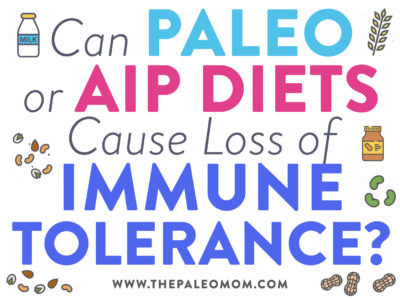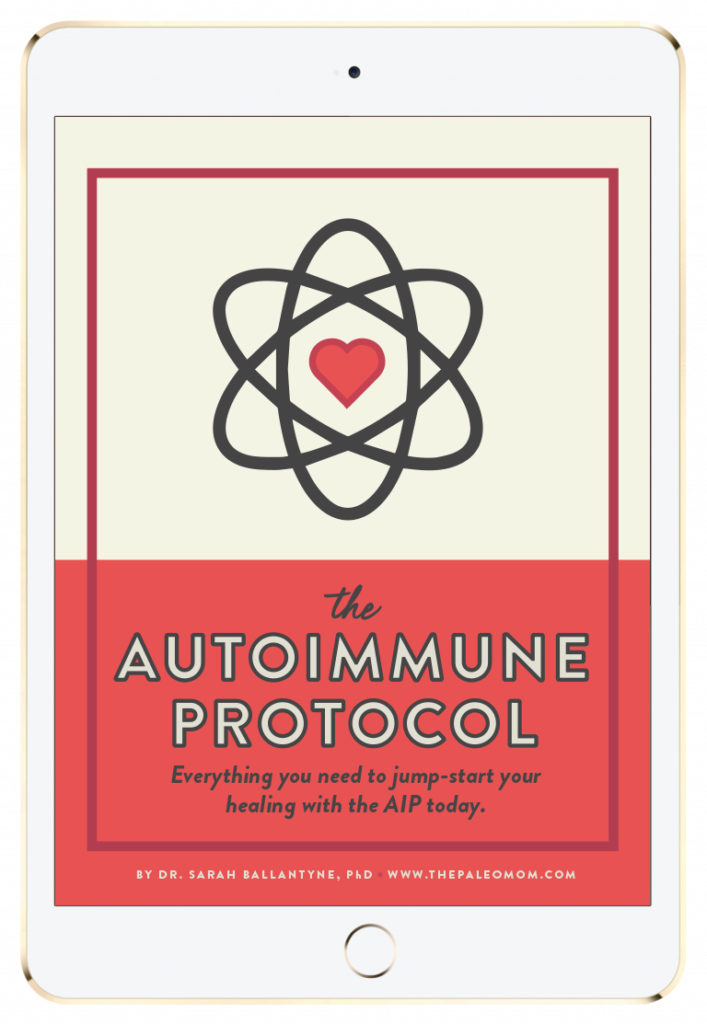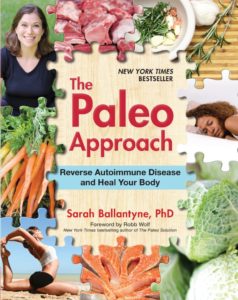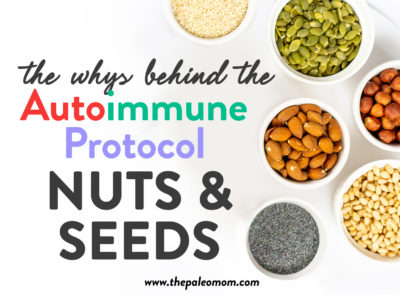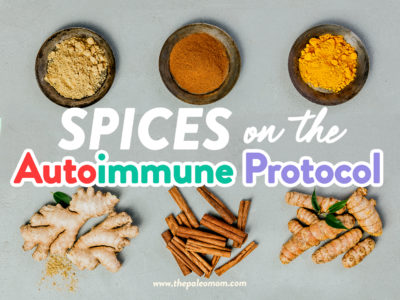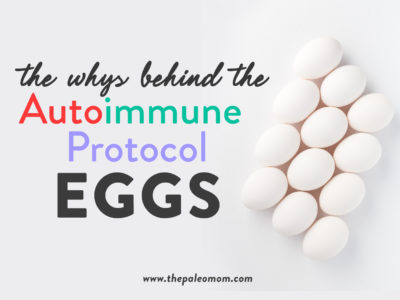In a previous post, we looked at the development of immune tolerance (the body’s lack of reaction to antigens that could potentially trigger an immune response) in the context of children (see “Development of Immune Tolerance in Children”). Research shows that early introduction of very small amounts of the most common allergens (like gluten, dairy, peanuts, and fish) can help prevent food allergies from developing later on, especially when those foods are introduced in conjunction with probiotics and proteins delivered through breast milk. But, what about adults?! There have been concerns that diets eliminating wheat, dairy, peanuts, and other allergenic foods (as happens on strict Paleo and AIP) could cause us to lose tolerance to things we previously could handle. As a result, we might wonder if we should keep eating at least small amounts of allergenic foods on a regular basis to prevent this from happening!
Unfortunately, immune tolerance in adults doesn’t receive as much discussion as it does in children, so it can be hard to know how to approach this issue. Should we eat a few bites of bread or peanut butter each week to help maintain immune tolerance, even in an otherwise Paleo or AIP diet? Or, would it do more harm than good to keep these things in our diet, especially while we’re trying to heal? Let’s look at what the science has to say!
Allergy, Intolerance, or Sensitivity?
First of all, let’s define our terms! When we find ourselves reacting negatively to the foods we eat (especially to foods we once handled just fine!), it’s important to distinguish between an allergy, intolerance, and sensitivity. These words are sometimes thrown around interchangeably, but they all mean very different things.
Food allergies are immune reactions where the body produces Immunoglobulin E (IgE) antibodies against a food protein, leading to a histamine release from two types of immune cells (mast cells and basophils). This results in allergy symptoms like hives, rashes, abdominal pain, bloating, sneezing, coughing, wheezing, shortness of breath, runny nose, red or itchy eyes, skin flushing, or swelling of the lips, nasal tissues, eyes, ears, face, tongue, and/or throat. These reactions can range from subtle (like mild seasonal allergies) to dramatic (as with anaphylaxis, a life-threatening reaction characterized by hives, severe swelling, trouble breathing, and shock). Allergies occur very quickly after ingesting the triggering food.
Food intolerances are reactions to food that aren’t immune in nature (that is, they don’t trigger antibody production). In some cases, like with lactose intolerance, food intolerances are caused by enzyme deficiencies that prevent us from properly breaking down food components. Unlike allergies, food intolerances tend to have side effects that are primarily gastrointestinal (cramping, bloating, diarrhea, upset stomach, and/or gas), and that, unlike severe allergies, aren’t life-threatening. Symptoms can also take a longer time to appear, anywhere from several hours to several days!
Food sensitivities have a less consistent definition in the medical field, but they generally involve a food-directed immune reaction other than an IgE response (other responses include IgG, IgA, or IgM antibody production). An immune reaction of this nature can result from leaky gut, which allows proteins from virtually any food we eat to cross the gut barrier, interact with the immune system, and cause unpleasant symptoms (see What Is A Leaky Gut? (And How Can It Cause So Many Health Issues?)). Other mechanisms that result in adverse food reactions include through the effects of severe gut dysbiosis (production of bacterial metabolites, for example, may be the cause of a sensitivity), or from an inability to process or metabolize a substance (which can cause inflammation, damage to the gut, strain on the liver, or damage to other tissues). Like food intolerances, non-IgE immune reactions (such as salicylate sensitivity, histamine sensitivity, and sulfite sensitivity) can produce gastrointestinal symptoms, but often include allergy-like reactions as well, such as itchy skin, hives, rashes, headaches, and low blood pressure. (For information on how to get tested for food sensitivities, see “Guest Post by Dr. Kellie Ferguson: Food Sensitivity Testing – Let’s Talk About Your Options!”)
Why is it important to distinguish between all these reactions? Because their causes and treatments are very, very different! True food allergies are unlikely to be either caused or reversed by adopting a different diet, although in some cases, Paleo or AIP may help reduce the severity of symptoms (through providing nutrients important for immune regulation). Non-IgE-mediated intolerances, on the other hand, tend to be much more transient and reversible with dietary modifications. If we avoid the foods we’re intolerant to and take measures to restore our gut barrier function, we can often re-introduce those foods later on without adverse reactions. (For example, with careful avoidance, IgG antibodies against food disappear within three months to two years (depending on how high they were initially), at which point we may be able to eat them again without problems.) Food sensitivities, likewise, can often be treated when we approach them from the angle of gut health, and/or temporarily avoiding the offending food components, like FODMAPS.
With all this in mind, we should be getting the picture that so-called restrictive diets like Paleo (I say “so-called,” because diversity is really the cornerstone of Paleo!) don’t sentence us to a loss of immune tolerance. But, that doesn’t answer the question of why some of us start reacting to foods we previously could handle after we’ve switched to a healthier diet. What’s going on here?
How Do We Lose Immune Tolerance?
As adults, we’ve already passed the stage where IgE-mediated food allergies tend to first begin (in infancy and early childhood). But, food allergies can develop at any point in life, including adulthood! In fact, a recent survey of almost 54,000 adults found that roughly half (47%) of all adults allergic to shellfish or nuts had developed at least one of their allergies after they turned 18. Additional research shows that when allergies do develop in adulthood, they usually begin when people are in their early 30s. Individuals with a history of getting hay fever and/or eczema have also been shown to have higher risk of developing food allergies as an adult.
Researchers are still trying to figure out what causes us to develop allergies to foods we previously handled just fine. Environmental exposures, viral infection, hormonal changes (such as during pregnancy, when hormonal shifts designed to protect the baby also impact immune function), and exposure to certain proteins while we’re in a state of weakened immunity all may play a role in allergy development. In some cases, a form of cross-reactivity called oral allergy syndrome occurs, where people start reacting to foods (especially certain fruits and vegetables) that contain proteins similar to those of an existing environmental allergy (such as latex, some plant pollens, or poison ivy). This is why, for example, people with a latex allergy might have to also avoid bananas!
Save 70% Off the AIP Lecture Series!
Learn everything you need to know about the Autoimmune Protocol to regain your health!
I am loving this AIP course and all the information I am receiving. The amount of work you have put into this is amazing and greatly, GREATLY, appreciated. Thank you so much. Taking this course gives me the knowledge I need to understand why my body is doing what it is doing and reinforces my determination to continue along this dietary path to heal it. Invaluable!
Carmen Maier
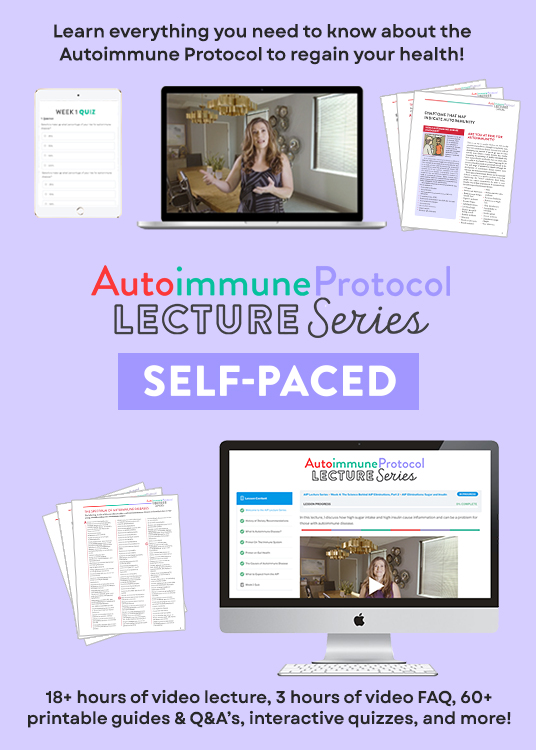
When it comes to diet, though, allergies do not develop as a result of avoiding a food for too long! The early, regular exposure that plays a role in first developing immunity during infancy doesn’t have an equivalent mechanism in adults. In other words, we can’t induce a soy allergy by going a year without eating soy; we can’t induce a shellfish allergy by not eating prawns frequently enough; and we won’t go into anaphylaxis just by having spent too much time away from peanuts, and then one day eating a spoonful (or three) of peanut butter straight out of the jar! Likewise, routinely eating small amounts of a true allergen won’t help us build immune tolerance towards it. This simply isn’t how IgE-mediated allergies work in adulthood.
Intolerances and sensitivities are a different story, though! With any radical dietary shift, including Paleo or AIP, some people find themselves reacting differently to foods they’ve eaten many times before. In some cases, these changes are positive: a well-implemented Paleo diet has many elements that support gut health (such as higher fiber intake and short-chain fatty acid production, greater nutrient density, greater omega-3 intake, and the removal of food components that contribute to leaky gut, like gluten and lectins in other grains; see What Should You Eat To Heal a Leaky Gut?), creating a situation where gut barrier function is strengthened and digestion improves. Likewise, the removal of foods we previously had non-IgE immune reactions to can help us recover from the sensitivity, to the point where we may eventually be able to reintroduce the food without reacting. This is because when we avoid a triggering food, the plasma cells responsible for making antibodies against that food eventually die off (since they have finite lifespans). If we wait until these antibody-producing cells are gone, we can often get away with occasional (weekly to monthly!) consumption without experiencing a noticeable reaction. And, if we wait an even longer time until memory B cells specific to that food (which our body makes to help remember things we’ve fought before) have also died off, while also improving our immune system and healing our gut, it’s possible that our immune system won’t remember we ever had a problem with the food in question! That means freedom to enjoy that food at our leisure (assuming it’s something we actually want to keep in our diet). (We should note that memory B cells have a shorter lifespan when they remember IgG reactions than IgE reactions, which is why it’s much more likely we can reverse a food sensitivity (IgG reactions) than a true allergy (IgE reactions).)
So, if eating Paleo (or other food group-eliminating diets) can’t produce a true allergy and also has the potential to heal food sensitivities, why do some Paleo adherents report adverse reactions to foods they used to handle just fine? What’s going on here?!
Can Paleo Lead to Food Sensitivities?
Despite its tremendous healing potential, there are legitimate ways that eating Paleo (depending on how it’s implemented!) could make us more sensitive to certain foods. The most likely possibilities are:
- We haven’t avoided a trigger food for long enough. As we just learned, after the cells producing antibodies against a certain food have died off, we can often re-introduce that food (at least on a limited basis) without problems. But, there’s a catch! If we eat the triggering food again before these cells have all died off, we might actually have an exaggerated reaction to the food. That leads us to think we’ve become more sensitive to it, when in reality, we were in the middle of a longer-term healing process! See also Reintroducing Foods after Following the Autoimmune Protocol
- We’re not eating enough fiber or Paleo-friendly carbohydrate. When we make major overhauls to our diet, the composition of our gut microbiome can shift considerably—especially in response to changes in fiber and other fermentable carbohydrates. In the case of a well-designed Paleo diet (nutrient dense, veggie- and fiber-rich, roughly equal macronutrient ratios, and containing some probiotics), those shifts should overall be very positive, leading to stronger gut barrier function and higher production of short-chain fatty acids derived from fiber (which in turn influence immune function and may help reduce allergies, among many other things!). But, things can head south if we adopt a Paleo diet that’s extremely low in carbohydrates, especially in fiber and resistant starch. Without properly feeding our gut microbes with fermentable substrates, we reduce our production of short-chain fatty acids, cause shifts in the pH of the colon towards greater alkalinity, allow proliferation of pathogenic bacteria (including E. coli and Salmonella) that are normally kept in check by colonic acidity, and possibly even increase our risk of different forms of Irritable Bowel Disease, which has strong links to butyrate levels. In other words, starving our guts of Paleo-friendly carbohydrates can have a net negative effect on our gut health, leading to gut-centered health problems such as new food sensitivities. (Moral of the story: eat your veggies, and don’t hop on the super-low-carb bandwagon unless you have a health condition that truly mandates it!) See also The Importance of Vegetables, How many carbs should you eat?, 5 Reasons to Eat More Fiber, and Resistant Starch: It’s Not All Sunshine and Roses
- We’re eating too much saturated fat. I know it’s practically blasphemous to say this, but it is possible to eat too much saturated fat—and when we do, the impact on our gut health can be less-than-rosy. A number of studies have shed light on the ways saturated fat can interact with our gut microbiomes, including increases in the Firmicutes-to-Bacteroidetes ratio and a decrease in bacterial diversity. The impact appears to be particularly harmful when a high saturated fat intake is coupled with a low fiber intake. And, some studies have shown that a high saturated fat intake can increase intestinal permeability—a surefire way to raise our risk of immune reactions to food, due to proteins crossing the intestinal barrier and interacting with our immune system! (For more on this topic, see “Saturated Fat: Healthful, Harmful, or Somewhere In Between?”)
- We’ve uncovered an intolerance or sensitivity that was already there—we just didn’t notice it before. When we’re eating a Standard American Diet, we often don’t realize how bad we feel until we experience much better health (including digestive health!) to give us some perspective. So, when we go Paleo and feel long-standing digestive discomfort and adverse food reactions disappear for the first time, the reintroduction of offending foods can feel pretty dramatic by contrast. In some cases, we had been silently suffering for years and just learned to dismiss our symptoms as a normal part of life.
- We’ve induced a temporary and reversible intolerance. This is where reports of newly acquired “lactose intolerance” following dairy avoidance fit in! Some people who omit dairy for a length of time notice digestive distress when they start eating it again, with the first exposure being the worst and subsequent exposures being progressively less symptomatic. When this happens, it’s often not because the person lost lactose tolerance, but because they didn’t actually have true lactose tolerance to begin with! Here’s what’s going on. In lactase non-persistent people (who lose lactase expression early in life), regular dairy consumption can lead to microbiome adaptation that allows them to digest lactose via lactose-eating or lactase-secreting bacteria in the gut. In that sense, dairy foods may act like prebiotics, creating a microflora profile that allows people who are genetically lactase non-persistent to eat dairy without symptoms. But, when dairy consumption is discontinued, the microbiome may shift and temporarily lose its lactose-handling ability, leading to digestive distress when dairy is introduced. However, the microbiome can likely be “re-trained” once dairy is back on the menu regularly, causing symptoms to once again disappear (according to the available evidence, this can take as little as 3-4 weeks). Interesting stuff, huh?!
The Real Secret to Food Tolerance: Gut Health!
With all this in mind, it should be clear that avoiding allergenic foods on Paleo is, itself, not going to cause a true loss of immune tolerance. So, there’s no reason to routinely eat foods like gluten grains, dairy, soy, or peanuts just to avoid developing an IgE allergy. And, when it comes to non-IgE intolerances and sensitivities, avoiding specific foods is also incredibly unlikely to cause a permanent inability to ever handle them again. At worst, we might find ourselves reacting strongly to an initial re-introduction of a food after a period of avoidance. Any negative reactions that happen outside of these scenarios are due to factors other than eliminating a specific food!
So, more than deliberately exposing ourselves to allergenic foods, what we should really be focusing on is supporting our gut health in every way possible! This is at the heart of the issue, and where most intolerances and sensitivities really originate. Even on Paleo, there are absolutely some diet and lifestyle choices that can cause gut dysbiosis and affect our ability to handle otherwise nutritious foods. Here’s how to strengthen our gut health and preserve our ability to eat our favorite foods without negative consequences!
- Eat a ton of vegetables and Paleo-friendly (non-grain) fiber! We’re talking 8+ servings a day here, and at least 25 – 30 grams of fiber. These levels will support an abundance of beneficial bacteria, including the all-important butyrate producers, and ensure our colon keeps a healthy level of acidity by encouraging bacterial fermentation. See The Importance of Vegetables
- Get enough sleep and manage stress (two major non-dietary factors that impact the gut microbiome!). (See “10 Tips to Improve Sleep Quality.”)
- Avoid ketogenic and otherwise very-low-carbohydrate diets. Although these diets do have therapeutic value in some situations, they risk having an overall negative impact on the gut microbiome, and they’re more likely to narrow the range of foods we can comfortably handle rather than widen that range (keep in mind, a cornerstone of paleo is diversity!).
- Fill your life with gentle, frequent physical activity, but don’t overtrain! Excessive exercise increases susceptibility to immune-related conditions and, importantly, can lead to leaky gut. (See “Why Exercising Too Much Hurts Your Gut.”)
- Consume plenty of omega-3 fats (hello seafood!) and go easy on the saturated fat. Together, these two “fat habits” will help improve the integrity of the gut barrier and reduce the risk of food proteins entering circulation and triggering an immune response.
- One word: probiotics! Including a source of probiotic microbes in our diet, such as from fermented veggies or kombucha, helps contribute to the beneficial bacterial colonies in our gut. See The Health Benefits of Fermented Foods
- Focus on nutrient density. Organ meats, leafy green and colorful veggies, shellfish, bone broth, and other high-micronutrient goodies should be abundant in our diets. Maintaining excellent nutrient status goes a long way to support both gut and immune function. See The Importance of Nutrient Density
Bottom line, we really shouldn’t worry about Paleo, AIP, or other similar diets causing long-term harm due to avoiding certain foods. When new intolerances and sensitivities emerge, they generally have less to do with the fact our diet is Paleo or AIP, and more to do with shifts in the gut microbiome, nutrient status, and other changes that are secondary to the diets themselves. So, while deciding whether to take a nibble of a wheat product once in awhile or put peanut butter on your apple slices once a week is absolutely a personal decision, we don’t need to do these things to protect our long-term health!
Citations
Berin MC & Mayer L. “Can we produce true tolerance in patients with food allergy?” J Allergy Clin Immunol. 2013 Jan;131(1):14-22. doi: 10.1016/j.jaci.2012.10.058.
Boyce JA, et al. “Guidelines for the diagnosis and management of food allergy in the United States: report of the NIAID-sponsored expert panel.” J Allergy Clin Immunol. 2010 Dec;126(6 Suppl):S1-58. doi: 10.1016/j.jaci.2010.10.007.
David LA, et al. “Diet rapidly and reproducibly alters the human gut microbiome.” Nature. 2014 Jan 23;505(7484):559-63. doi: 10.1038/nature12820. Epub 2013 Dec 11.
Gocki J & Bartuzi Z. “Role of immunoglobulin G antibodies in diagnosis of food allergy.” Postepy Dermatol Alergol. 2016 Aug;33(4):253-6. doi: 10.5114/ada.2016.61600. Epub 2016 Aug 16.
Gupta R, et al. “OR077 The prevalence of nut and seafood allergies among adults in the United States.” Ann Allergy Asthma Immunol 2017;19(5):S11.
Kamar TA, et al. “Prevalence and characteristics of adult-onset food allergy.” J Allergy Clin Immunol Pract. 2015 Jan-Feb; 3(1): 114–5.e1.
Kemeny DM, et al. “Sub-class of IgG in allergic disease. I. IgG sub-class antibodies in immediate and non-immediate food allergy.” Clin Allergy. 1986 Nov;16(6):571-81.
Kumari R, et al. “Fluctuations in butyrate-producing bacteria in ulcerative colitis patients of North India.” World J Gastroenterol. 2013 Jun 14;19(22):3404-14. doi: 10.3748/wjg.v19.i22.3404.
Lam YY, et al. “Effects of dietary fat profile on gut permeability and microbiota and their relationships with metabolic changes in mice.” Obesity (Silver Spring). 2015 Jul;23(7):1429-39. doi: 10.1002/oby.21122. Epub 2015 Jun 5.
Kuo S-M. “The Interplay Between Fiber and the Intestinal Microbiome in the Inflammatory Response.” Advances in Nutrition. 2013;4(1):16-28. doi:10.3945/an.112.003046.
Leach, Jeff. “Sorry Low Carbers, Your Microbiome is Just Not That Into You.” Human Food Project. 26 June 2013. http://humanfoodproject.com/sorry-low-carbers-your-microbiome-is-just-not-that-into-you/
Szilagyi A. “Adaptation to Lactose in Lactase Non Persistent People: Effects on Intolerance and the Relationship between Dairy Food Consumption and Evalution of Diseases.” Nutrients. 2015 Aug 13;7(8):6751-79. doi: 10.3390/nu7085309.
Vickery BP, et al. “Mechanisms of immune tolerance relevant to food allergy.” J Allergy Clin Immunol. 2011 Mar;127(3):576-84; quiz 585-6. doi: 10.1016/j.jaci.2010.12.1116. Epub 2011 Jan 31.
Wawrzyniak M, et al. “Role of Regulatory Cells in Oral Tolerance.” Allergy Asthma Immunol Res. 2017 Mar;9(2):107-115. doi: 10.4168/aair.2017.9.2.107.

